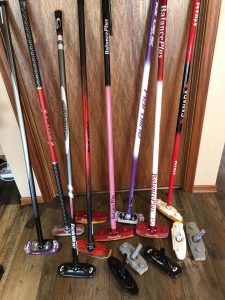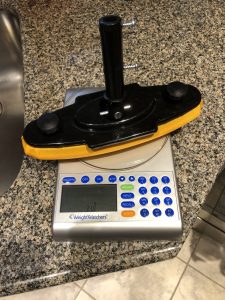During my talk at the online Adapting/Thriving 2021 Conference presented by the Ontario Curling Council, and other provincial sport organizations, I made several statements regarding potential parameters to the selection of a brush, among them being the size of the brush pad and its contact area with the ice. Even though WCF-approved brush heads and pads all utilize the same Oxford 55 420D yellow nylon fabric, and are tested by the National Research Council for compliance with World Curling Federation specifications, there are differences amongst the available products. Some brush pads have an integrated design, comprising the base, foam, and fabric as a single unit, whereas other brush pad designs use separate components so that the Oxford 55 fabric can be replaced independently of the foam or base. Perhaps the most interesting brush to do this is the End Game brush from Madison, Wisconsin, where the replacement fabric comes simply in die-cut sheets of Oxford 55 nylon. With the End Game, brush fabric can be quickly replaced by wrapping the new fabric around the brush head foam using plastic “pins” to keep the fabric in place. Another difference amongst the manufacturers is that different brush pads have different types and thickness of foam – still meeting WCF specifications – in addition to differing contact areas with the ice surface; some pads are very flat, whereas other pads are more rounded, offering the athlete a different “feel”.
However, a significant difference amongst the brushes from various manufacturers is the mass of the head itself. I mentioned this in my Adapting/Thriving 2021 talk because the mass of brush head can be an important consideration in the selection of a brush: lighter heads are usually preferred to heavier models as heavier models can lead to greater fatigue. Fatigue may not be noticeable by every athlete, and may not be felt during a single game, but in my experience athletes who compete in competitive events and play 6-10 games over a single weekend do notice fatigue, and in that respect the mass of the brush head can play a role.


| Manufacturer | Model | Brush head mass (grams) | Brush pad width (cm) | Brush pad area (sq cm) |
|---|---|---|---|---|
| Balance Plus | LiteSpeed, 23mm mandrel | 146 | 18.5 | 118.4 |
| Balance Plus | LiteSpeed RS, 23mm mandrel | 158 | 19.0 | 130.2 |
| Balance Plus | LiteSpeed XL, 23mm mandrel | 167 | 22.5 | 145.7 |
| Olson | Pyro | 177 | 19.5 | 115.1 |
| Balance Plus | LiteSpeed RS XL - 23mm mandrel | 178 | 22.6 | 149.7 |
| Balance Plus | LiteSpeed RS XL - 26mm mandrel | 179 | 22.6 | 149.7 |
| Goldline | Air | 203 | 19.2 | 119.8 |
| End Game | Red | 220 | 22.8 | 156.1 |
| Goldline | Air X | 221 | 20.7 | 133.2 |
| Hardline | Ice Pad | 229 | 20.1 | 142.4 |
| Performance | Oval head with Asham brush pad | 293 | 22.3 | 131.6 |
| Balance Plus | Oval head with Goldline brush pad | 306 | 22.6 | 138.9 |
| Asham | V2 Pro | 320 | 22.5 | 127.5 |
| Performance | Spyder | 211 | 20.2 | 132.2 |
| Asham | Ultra Force | 221 | 19.8 | 138.6 |
| Goldline | Impact | 205 | 19.0 | 123.4 |
For completeness, I’ve included the width of the brush pad used with that head assembly for comparison. Note that this width is the entire width of the pad – the actual contact area of the pad is smaller, and its dimensions vary by brush.
Update (6 July 2022): I’ve added an additional column to the table that gives the brush pad’s area for each brush listed. For brushes that use replaceable “sleeves”, rather complete units, the area measurement given is the area of the foam pad to which the sleeve is fitted. Note that the pad area, which is given in square centimetres, should not be taken as the pad’s contact area on the ice. Some brush pads, notably the Performance Spyder, are very flat and most if not all of the brush pad is in contact with the ice at all times. Other pads, for example the Goldline “Oval” pad, is convex in shape, with a thickness of 13 mm at the edges and 20 mm in the middle. As the foam is compressed to varying degrees when under load, the contact area of the pad will be smaller than the pad’s overall size, but exactly how large this area will be will depend on the force provided by the athlete.
From the table, we see that we have a set of WCF-approved head assemblies whose mass ranges from 146 grams to more than double that at 320 grams. How significant a difference is that, really? Let’s do some arithmetic to compute the difference between the use of two heads in a single-game situation. To illustrate, we’ll compare a Balance Plus LiteSpeed RS XL head (23 mm mandrel) at 178 grams with a Performance head with an Asham oval pad that weighs 293 grams. I use these two brush heads as examples because (a) the brush pads are approximately the same physical dimensions (22.6 cm in width vs. 22.3 cm) and (b) both head assemblies fit a standard Balance Plus “EQ” handle of 1-1/8 inch diameter, permitting us to focus on only the brush head weight as the differentiator. To make the arithmetic easier we’ll make a number of simplifying assumptions:
- The player using the brush is the lead, brushing four of six stones per end (two stones per end are unswept).
- All games are fully 8 ends.
- All four shots that are brushed are draws, taking 24 seconds from near hog line to far tee-line.
- Each of the four stones that are brushed are brushed for only 1/2 of their total travel time, or 12 seconds.
- The athlete brushes at a typical four strokes/second. As each stroke results in two start/stop transitions from the push/pull of the brush head, eight motion transitions occur per second.
With these simplifying assumptions, during a game the total number of brush head transitions that the athlete will generate through the push/pull of their brush strokes totals 4x8x12x8 or 3,072. With a difference in mass between the two brush heads of 115 grams, the total extra mass that has to be managed by an athlete using the Performance brush during that 8-end game is 3072 x 115 g, or approximately 353 kilograms. Over an 8-game event (5 round-robin games and 3 games of playoffs) that difference in weight totals 8×353 kg, or an additional 2.8 metric tonnes.
I think that some athletes, particularly younger athletes, will find that difference significant. Is it the only difference of concern? No. The weight of the handle does play a role, and brush manufacturers continue to develop better, lighter handles to reduce the brush’s overall weight, along with different handle materials that facilitate better grip. Other factors include the width of the brush pad, its contact area, the pressure distribution over that contact area when under load, and the outside diameter of the handle, especially above the brush head where one’s lower hand would grip the brush. My point is that I would recommend that teams test different brushes in practice before committing to a specific model or manufacturer. In golf, even recreational golfers will try a new set of irons or a driver before committing to purchase, and there are significant differences amongst club brands even though the PGA has established equipment standards: different grip sizes, shaft and club head material, shaft flexibility, and so on. In curling, even though the WCF has standardized the fabric and the pad’s characteristics for competitive play, there are significant differences amongst the available products and a single brush may not necessarily suit every player.
My thanks to Jennifer Ferris of the Ontario Curling Council for supporting us in this work, and to Dale Matchett at Balance Plus for providing the Balance Plus LiteSpeed head assemblies that appear in this survey.
Very amazing and comprehensive. Out of curiosity, is it possible to mix and match different heads with different handles? Obviously, they have to be the right mandrel size, so assuming it is the right size, but as an example: would a Goldline Impact head, and a BalancePlus handle work together? Or are the fastener location/type going to be an issue?
It’s not an easy question, but any info helps. Thanks!
Yes, after recently confirming with Scott Arnold of the WCF, one can mix-and-match handles and WCF-approved brush heads from different models and/or manufacturers in competitive play. It isn’t clear to me to the extent that “customization” might be permitted in order to get a handle and mandrel to fit properly; one might want to check with your association before you do so. Some of the manufacturers make this fairly straightforward; as an example, Hardline makes an adapter that permits a IcePad brush head to be used with a standard 1 1/8 inch Balance Plus handle that fits a 23mm mandrel.
One caution I would make to any reader: one is not permitted to mix-and-match brush head components from different designs or manufacturers. For example, in competition it is not permitted to use (say) a Goldline Impact sleeve with a Hardline IcePad brush head assembly, or vice-versa. Or to use the foam insert from one brush in another of a different make. The WCF approves brush heads as complete units, even though it is only the sleeve or pad that is stamped with the approval code.